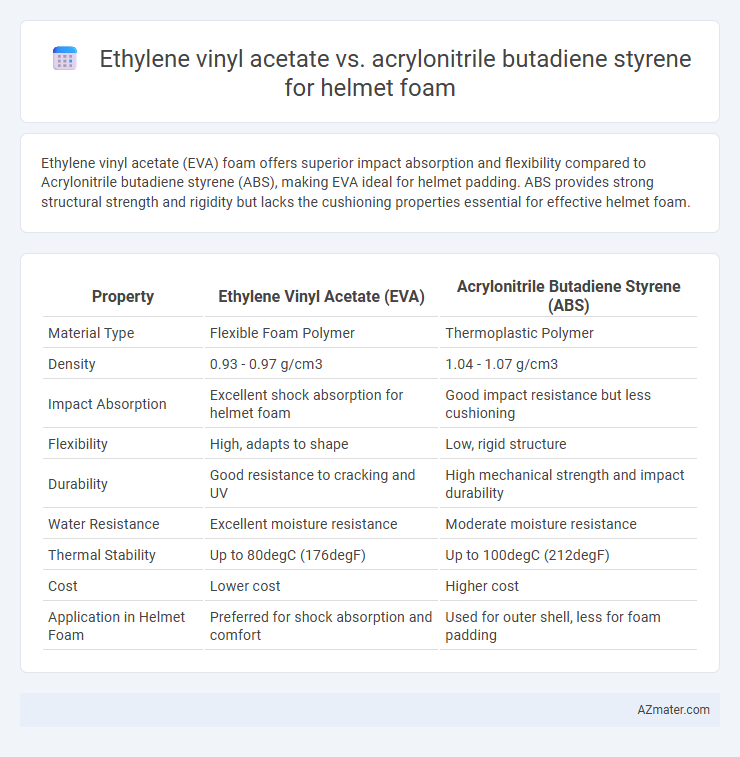Ethylene vinyl acetate (EVA) foam offers superior impact absorption and flexibility compared to Acrylonitrile butadiene styrene (ABS), making EVA ideal for helmet padding. ABS provides strong structural strength and rigidity but lacks the cushioning properties essential for effective helmet foam.
Table of Comparison
| Property | Ethylene Vinyl Acetate (EVA) | Acrylonitrile Butadiene Styrene (ABS) |
|---|---|---|
| Material Type | Flexible Foam Polymer | Thermoplastic Polymer |
| Density | 0.93 - 0.97 g/cm3 | 1.04 - 1.07 g/cm3 |
| Impact Absorption | Excellent shock absorption for helmet foam | Good impact resistance but less cushioning |
| Flexibility | High, adapts to shape | Low, rigid structure |
| Durability | Good resistance to cracking and UV | High mechanical strength and impact durability |
| Water Resistance | Excellent moisture resistance | Moderate moisture resistance |
| Thermal Stability | Up to 80degC (176degF) | Up to 100degC (212degF) |
| Cost | Lower cost | Higher cost |
| Application in Helmet Foam | Preferred for shock absorption and comfort | Used for outer shell, less for foam padding |
Introduction to EVA and ABS in Helmet Foam
Ethylene vinyl acetate (EVA) offers lightweight cushioning and excellent shock absorption, making it a preferred material in helmet foam for impact protection. Acrylonitrile butadiene styrene (ABS) provides a rigid outer shell with high impact resistance and durability, commonly used in helmet exteriors to enhance structural integrity. Combining EVA foam with an ABS shell optimizes helmet safety by balancing comfort, flexibility, and robust outer protection.
Chemical Structure and Properties Overview
Ethylene vinyl acetate (EVA) exhibits a flexible copolymer structure with alternating ethylene and vinyl acetate units, enabling excellent impact absorption and shock resistance, essential for helmet foam applications. Acrylonitrile butadiene styrene (ABS) features a terpolymer composition combining acrylonitrile, butadiene, and styrene, providing superior toughness, rigidity, and thermal stability for protective gear. The chemical structure of EVA supports enhanced cushioning through its elastomeric properties, while ABS delivers structural integrity and resistance to deformation under stress.
Impact Absorption Capabilities
Ethylene vinyl acetate (EVA) foam offers superior impact absorption due to its excellent energy dissipation and cushioning properties, making it an ideal choice for helmet foam. Acrylonitrile butadiene styrene (ABS), while rigid and durable as a shell material, provides limited impact absorption compared to EVA foam. The enhanced flexibility and shock-absorbing characteristics of EVA significantly reduce concussion risks by effectively dissipating impact forces.
Weight and Comfort Comparison
Ethylene vinyl acetate (EVA) foam offers superior cushioning with a lighter weight profile compared to Acrylonitrile butadiene styrene (ABS), making it ideal for helmet padding focused on reduced fatigue and enhanced comfort. ABS provides a rigid, impact-resistant structure but contributes to a heavier helmet, potentially compromising long-term wearer comfort. The inherent flexibility and softness of EVA foam improve shock absorption and wearer comfort, whereas ABS's durability benefits external shell protection rather than internal cushioning.
Durability and Aging Resistance
Ethylene vinyl acetate (EVA) offers superior flexibility and impact absorption, making it highly durable for helmet foam, while maintaining excellent aging resistance against environmental factors such as UV exposure and moisture. Acrylonitrile butadiene styrene (ABS) provides strong structural integrity and impact resistance but tends to exhibit reduced aging resistance, with potential brittleness developing over extended exposure to heat and UV radiation. EVA's combination of elasticity and stable polymer matrix makes it a preferred choice for long-lasting helmet foam in rugged and variable environmental conditions.
Manufacturing and Processing Differences
Ethylene vinyl acetate (EVA) foam offers superior flexibility and shock absorption, making it ideal for helmet interiors that require high energy absorption and comfort during impact. In manufacturing, EVA foam undergoes a gas-injection or chemical foaming process that can be customized for density and thickness, allowing precise control over cushioning properties. Acrylonitrile butadiene styrene (ABS), a rigid thermoplastic, involves injection molding or extrusion processes to produce a hard outer shell, providing structural integrity and durability but less flexibility than EVA foam.
Cost Analysis of EVA vs ABS
Ethylene vinyl acetate (EVA) foam is generally more cost-effective than acrylonitrile butadiene styrene (ABS) for helmet foam applications due to its lower material and processing expenses. EVA offers superior shock absorption at a reduced price point, making it ideal for budget-conscious manufacturers seeking reliable impact protection. ABS, while more expensive, provides higher structural rigidity and durability but often results in increased production costs and final product pricing.
Safety Standards and Certification Compliance
Ethylene vinyl acetate (EVA) foam offers superior impact absorption and shock attenuation, meeting high safety standards such as EN 1078 and ASTM F1447 for helmet protection. Acrylonitrile butadiene styrene (ABS) shells provide rigidity and structural integrity but require an inner foam layer, often EVA or expanded polystyrene, to comply with certification requirements like CPSC and Snell. Helmets combining EVA foam with ABS shells typically achieve better compliance with multi-regional safety certifications due to enhanced energy dispersion and durability.
Environmental Impact and Recyclability
Ethylene vinyl acetate (EVA) foam offers superior environmental benefits for helmet padding due to its non-toxic composition and higher biodegradability compared to acrylonitrile butadiene styrene (ABS), which is a petroleum-based thermoplastic with slower degradation rates and higher carbon footprint. EVA's recyclability is enhanced by its compatibility with mechanical recycling processes, allowing foam materials to be reprocessed with minimal quality loss, whereas ABS recycling often requires energy-intensive methods such as chemical recycling or pyrolysis. Choosing EVA foam for helmets supports reduced environmental impact through lower greenhouse gas emissions and increased circularity in material use.
Final Recommendations for Helmet Manufacturers
Ethylene vinyl acetate (EVA) offers superior energy absorption, flexibility, and lightweight properties, making it ideal for helmet foam used in impact protection. Acrylonitrile butadiene styrene (ABS) provides excellent rigidity and durability but lacks the cushioning performance critical for user safety in helmets. Helmet manufacturers should prioritize EVA foam to enhance comfort and shock absorption while considering ABS primarily for outer shell applications rather than internal padding.

Infographic: Ethylene vinyl acetate vs Acrylonitrile butadiene styrene for Helmet Foam
 azmater.com
azmater.com